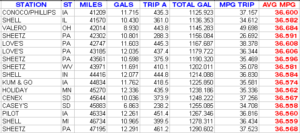Do you still remember when gas stations were full-serve? I can clearly remember mom stopping at Bup’s Esso Station. We would drive over a hose in the driveway that would ring a bell that would alert the attendant. He would ask what grade of gas we wanted and how much.
“Fill-’em up with high-test.”
After placing the nozzle in the tank, he would wash the windshield and pop the hood to check the oil level — and sometimes we would need a quart. If we did, he would select the oil can, puncture the lid with a metal spout and pour it in.
I can still see the numbers spinning on the dial until the nozzle clicked. Then the attendant would squeeze a little more gasoline in the tank until it came to an even number! When mom paid, she also handed him a stiff paper card with a red circle on it. I believe you would get it punched every time you filled your tank and then when it was complete, you would peel back the paper circle to see what you won — maybe a discount on your gas purchase. Although there are still attendants in a few states, it’s not like it used to be.
Keeping Track
One of the more interesting things I discovered about driving is that the gasoline that you use in your car can make a huge difference in the mileage you get. I had started keeping a log for my 2009 Civic that kept track of the number of gallons and the miles between fill-ups. From this, I was easily able to calculate the miles per gallon for that tank and kept a running total. The per-tank mpg is not going to be perfect, because it is dependent on how empty the tank was and how full you fill it, but the running total is a really good indicator of how your car is performing.

I highly recommend this, as if you see a sustained decrease in your gas mileage, you may have an issue with your car that you need to address. When I am running locally, I always use Sheetz gas, and my mileage has been remarkably consistent. When I am travelling, I’ve had success with Mobil, Exxon, Valero, Shell, Phillips 66, Conoco, Union 76 and Sinclair. Also, the fuel I’ve gotten from the major truckstop chains has been good, as well. I’m not here to knock any petroleum outlets, but there are certain brands of gasoline that do not seem to function well with my car, so I avoid them.
Keep it Full
One last piece of advice that I have is to fill your tank before it is nearly empty. When the tank is very low, it can cause various problems, and completely running out can put quite a strain on your car. In the winter, I fill it more often and never let it run down below a quarter because I don’t want the gas line to freeze. Kramer’s test drive on Seinfeld was amusing, but in real life it could be life-threatening. Running out of gas can put you in serious danger, especially if it happens out on the highway. And I don’t even have to mention how bad it can be in the winter. It will be well worth it to fill-up when your tank reaches a quarter, rather than the hassle of dealing with an empty tank.
Cold Weather
I had an interesting experience with gasoline well over a decade ago in South Dakota. I was heading out west in December and there were storms in Nebraska and the southern half of the country, so I opted for Interstate 90. The sky was blue, as the “clearing front” had brought a polar high down from Canada with chilly air delivered directly from the Arctic Circle. The bright blue skies made for some beautiful photos of the Corn Palace at Mitchell, South Dakota, but the temperature was well below zero the whole day. I generally have a good idea of when I need to fill the tank, so I am not a “fuel gauge watcher.” What I didn’t take into account that day was how badly my gas mileage would be degraded by the cold temperatures.
One minute I was relaxing and enjoying the lack of traffic on the interstate, and then I saw a little flash out of the corner of my eye. I looked down in disbelief to see that the “fuel indicator” light was on… and I was in the middle of nowhere! I looked at my trip odometer and couldn’t believe how low the mileage was since the last fill-up. I passed a few stations in small towns, but they were closed. The next bigger town was Wall, and I had some tense moments as I kept one eye on the road and the other on the gas gauge. I breathed a sigh of relief as I exited I-90 and rolled into the gas station. I never go inside while the tank is being filled, but that day was the exception. Apparently the bitter cold temperatures affected the pumps, too, and it took ten minutes to fill the tank. Lesson learned. Not only does the cold temperature affect people, but machinery, as well. Now I’m more aware of the fuel level when it is really cold.
We have lots of cool T-shirts made especially for road trips!
As an Amazon Associate I earn from qualifying purchases.

